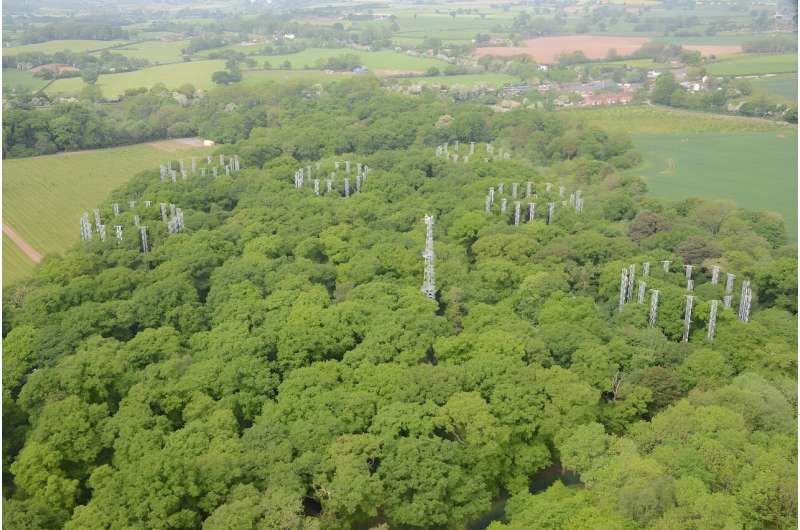This article has been reviewed according to Science X's editorial process and policies. Editors have highlighted the following attributes while ensuring the content's credibility:
fact-checked
trusted source
written by researcher(s)
proofread
Researchers pump extra CO₂ into an oak forest and discover trees will be 'woodier' in future

Oak trees accumulate more wood when there is more carbon dioxide (CO₂) in the atmosphere. That's the key finding from our new study, carried out in a long-established forest in Staffordshire, England, that we have turned into a huge field experiment by injecting with extra CO₂. After we increased CO₂ levels to what will be the planetary level in the 2050s, trees took more of it from the atmosphere and their wood production increased by 10%.
In some ways, this result is reassuring. We know that more CO₂ in the atmosphere can often help plants grow bigger and faster, since photosynthesis captures the carbon from which plants are largely made. However, until now, the only comparable study on an older, mature forest (an Australian eucalyptus forest) found no link between extra CO₂ and tree growth. Our work shows the link really does exist—at least in some common broadleaf forests.
But woodier trees do not offer a silver bullet to solve climate change. While carbon is certainly better off in trees than in the atmosphere, where it causes global warming, it's not a long-term solution. Over decades or centuries, wood rots away and carbon dioxide is released back into the atmosphere. So, as a store of carbon, trees are not remotely equivalent to it being locked away in coal seams and oil reservoirs deep underground.
To study what even more CO₂ in the atmosphere will do to trees in future, we used a technique called Free-Air CO2 Enrichment (Face). This involves installing eight-story high pipes on the upwind side of various patches of forest, and then gently releasing air infused with extra CO₂. We then monitor the trees to see if the CO₂ has had any effect.
Our new study uses patches of 180-year-old English or "pedunculate" oak (Quercus robur). These trees are much older than those studied previously to see how they will behave in the atmosphere of the future.
Some forests can't make use of extra carbon
Why did our research on oak trees generate different results from the research on Australian ecalyptuses, which found no link between CO₂ and wood growth?
The difference almost certainly lies in the nutritional condition of the two forests. Trees in forests need a balance of nitrogen (N) and phosphorus (P) and a host of "micro-nutrients" if they are to grow well. The Australian forest grows in ancient, "highly weathered" soil where any extra phosphorus is in very short supply, so that, even when given an extra supply of carbon "for free," the trees are unable to use it to lay down more plant material.
Such intense nutrient shortage does not exist in our oak forest, so the experiment more directly tests whether the trees can make use of the new "free" carbon resource. And it seems they can, especially to form wood.
Although every forest is unique one way or another, our results are likely to be relevant to many of the world's "temperate deciduous broadleaf" forests—those which are neither exceptionally hot or cold and which drop their leaves each year.
The Australian results perhaps point to how trees will respond in other phosphorus-limited environments, such as tropical rainforests. Scientists in Brazil are beginning a similar experiment at the Amazon Face facility, which comes on-stream later this year. That should add another crucial piece to the global forest carbon jigsaw, though other Face facilities elsewhere are also needed.
We did look for changes in other tissues—leaves, fine roots and seeds—in trees with elevated CO₂, but any extra growth was minimal, and not distinguishable from measurement uncertainties. In any case, these other tissues turn back into atmospheric CO₂ more quickly than woody tissue. So it is lucky that the extra carbon is being stored in "woodier trees," since the world's hopes for avoiding disastrous climate change are pinned on forests offsetting essential fossil-fuel use.
Provided by The Conversation
This article is republished from The Conversation under a Creative Commons license. Read the original article.![]()




















